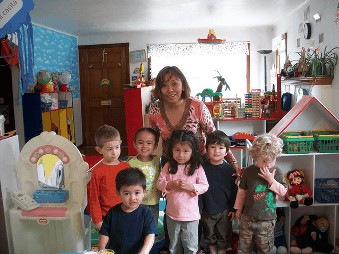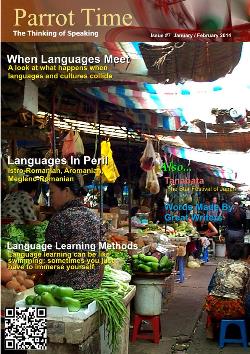
|
Perhaps the best method for learning a new language is that of immersion. It is generally described as the way we all learn our first language as children. The process is that a person is constantly surrounded by the new language, with people speaking only it, all the media being in it, and the person will only be understood properly when they speak it. They are "immersed" in a complete environment with the language. While it may be considered the best, it is also probably the hardest to obtain and maintain. Most of us don't have the opportunity to travel to a place where the language we are studying is spoken by most of the population, and we certainly don't get to spend a long enough time there to really learn the language fluently. Other, lesser measures are possible, but those can't possibly be as effective. Child's Play  Babies learn to their languge by listening to and watching the people around them. As children, we must learn to speak by listening and watching everyone and everything around us. We learn the language by not only hearing it but also by seeing what is referenced. For example, if an adult holds out an object to us and says "cookie", we associate that word with the object in their hand. When we want something, we point to it, and the adult will often tell us the word for it before handing it to us (or telling us "no!" if they we aren't allowed to have it, which just makes us want it even more). During this time, we also learn some of the rules of society by observing how people ask for things, how they greet each other, and how they interact in general. We learn to say "please" while pointing at the desired object, as we have seen others say "please" to receive things. Sounds Like It isn't all just words and gestures, though. We are also learning how to make the sounds of the language. This is something we often take for granted, but it is vital to making oneself fully understood. As children, we learn to mimic the sounds from those around us. As adults, it is much harder to do, for the sounds for our native tongue have already been developed and solidified while the sounds of the new language may be completely different or, worse, having a very slight variance that we have a hard time detecting yet practically shouts out to natives of our foreignness. It can't truly replace the experience everyone has in learning their native tongue, because we can never go back to being blank slates, but it is probably the closest one can get to that situation. Think of an Italian woman who is learning to speak English. While Italian has the letter "h" in its alphabet, it has no sound itself. It is used as a sound modifier, telling how the sound of an adjacent letter (normally a "g" or a "c") should be altered. The ci in ciliegia is pronounced like the ch in the English word church, but by adding the "h", we turn it into a hard "k" sound. Chilo is pronounced like the English kilo. Not a problem there, really, because the woman knows both those sounds already. However, the English sound of th is completely foreign and likely never used, except in some rare borrowed words. New sounds are a problem no matter what learning method is used, and immersion as an adult isn't likely to make it any easier. The only possible advantage is that you hear the new sounds as part of the entire process, so they aren't separated out first, as might be done in with other methods. That is, if the first thing about a language you learn is the sounds as they are applied to each letter or group of letters, your mind might balk at the strange sounds and make you more hesitant. Immersion might remove that hesitancy quicker and more naturally because these sounds aren't being given any special attention. Travel The best way to achieve immersion is, obviously, to travel to where one can surround oneself with native speakers. Our Italian woman would therefore benefit the most by traveling to the United Kingdom or the United States for a long period of time. While a short trip will get someone used to the sounds and possibly learn some new words, a long stay is really required. A few months would be the minimum amount of time spent in another country. Another factor in how effective the experience will be is how truly isolated a person is. If the Italian woman travels to London and stays with her Italian relatives there, she might not benefit as much if she speaks Italian with her family while there. Any amount of time spent on speaking one's native language can greatly dilute the immersion process. Immersion Schools  Students ages 2 to 5 learn math, science and art in a Spanish language immersion school. For those that can afford both the time and money, immersion schools could be very beneficial to them. These are normally held in a country in which the target language is spoken natively, but they also could be found in the student's homeland. In these schools, many subjects are normally taught, not just a language. The students are taught in the new language, which means that they truly need to learn the language in order to learn the material and pass the classes. Some schools might mix the new language with another, making the students bilingual over time. For example, the school might teach classes in 90% Spanish for the first year, then change to a mix of 80% Spanish and 20% English the next year. Eventually, the classes could be being taught in 50%/50% of both languages. This mixing can help in both the languages and the class materials. As the students progress in the Spanish, the English can be used to assist in learning more complicated or abstract concepts of Spanish. The English could also help in the learning of the subject of the class, enabling the students to learn the words in both languages. There are also some attempts being made at creating "Villages", in which a person will go to live in a facility in which they only use the taught language. These might me less intensive in terms of learning other subjects while offering residents a less formal atmosphere for learning, like they might get by living in another country for a time. These villages essentially become a much smaller version of another country.  Would you be daring enough to dive into an immersion course? Some places even offer similar programs in the forms of summer camps. Normal summer camps are usually where young people get to participate in summer activities they may not normally have access to at home, like sleeping outside, swimming, boating, and hiking. A language camp would similarly offer various activities, but these would be done only in the target language. It truly is a "sink or swim" proposition. Like the rather barbaric method of teaching a child to swim, which involved tossing them into a lake and thus forcing them to learn or sink to the bottom and drowned, immersion is dropping a person into a completely foreign environment and forcing them to learn to communicate with the natives or remain an outsider. As can be expected, this is not a process that everyone would wish or dare to attempt. |
| Language Learning Methods - Immersion | |||||||
| Writer: | Erik Zidowecki | ||||||
| Images: | |||||||
| |||||||
All images are Copyright - CC BY-SA (Creative Commons Share Alike) by their respective owners, except for Petey, which is Public Domain (PD) or unless otherwise noted.
comments powered by Disqus
















